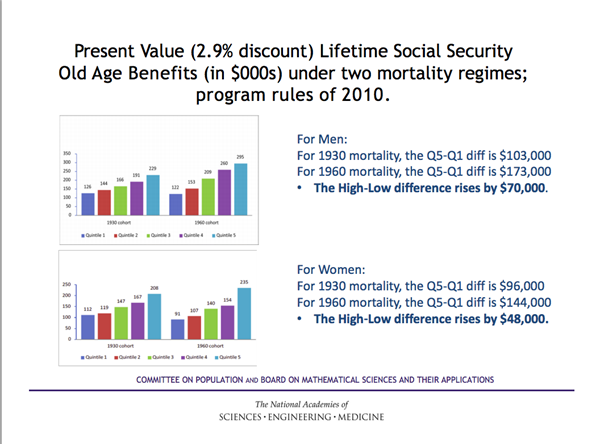MEDIA ADVISORY: The Growing Gap In Life Expectancy By Income
 The highest income earners are living longer and receiving more benefits from Social Security and Medicare programs than lower income earners, a new National Academies of Sciences, Engineering and Medicine report has found.
The highest income earners are living longer and receiving more benefits from Social Security and Medicare programs than lower income earners, a new National Academies of Sciences, Engineering and Medicine report has found.
CONTACT: Emily Gersema, (213) 740-0252 or gersema@usc.edu
FINDINGS: The report, The Growing Gap In Life Expectancy By Income, revealed the most significant impact could be made by raising the normal retirement age for Social Security benefits eligibility, or by raising the Social Security retirement age with the earliest eligibility age. However, the NAS did not issue any recommendations.
“The bottom line is that our social institutions are not keeping up with the demographic risks that the population now faces,” said Dana Goldman, a member of the NAS Committee on Long-run Macroeconomic Effects of the Aging U.S. Population — Phase II that contributed to the report.
“We need to do a better job adapting to the realities of human biology,” he said.
Goldman is the director’s chair of the USC Schaeffer Center for Health Policy and Economics and professor of the Price School of Public Policy and School of Pharmacy.
WHO: The 12-member NAS committee was co-chaired by Peter Orszag, vice chairman of Citigroup, and Ronald D. Lee, professor of demography and economics at University of California at Berkeley. The NAS Committee on Population and the Board on Mathematical Sciences and Their Applications also worked on the report.
WHY: The report builds upon a 2012 analysis and was developed in response to a congressional mandate to study the effect of the growing life-span divide for beneficiaries of Social Security, Medicare and Medicaid.
HOW: Some analysis for the report was based on a simulation model, the Future Elderly Model, developed by Schaeffer Center researchers for economic studies. The simulation considers health, disability and mortality outcomes while taking into account program costs and taxes.
The NAS news release is here.



